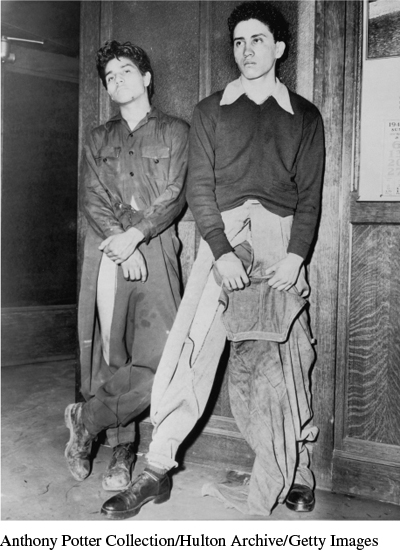Struggles for Mexican Americans
Immigration from Mexico increased significantly during the war. To address labor shortages in the Southwest and on the Pacific coast and departing from the deportation policies of the 1930s, in 1942 the United States negotiated an agreement with Mexico for contract laborers (braceros) to enter the country for a limited time to work as farm laborers and in factories. Braceros had little or no control over their living spaces or working conditions. Not surprisingly, they conducted numerous strikes for higher wages in the agricultural fields of the Southwest and Northwest. Most U.S. residents of Mexican ancestry were, however, American citizens. Like other Americans, they settled into jobs to help fight the war, while more than 300,000 Mexican Americans served in the armed forces.
The war heightened Mexican Americans’ consciousness of their civil rights. As one Mexican American World War II veteran recalled: “We were Americans, not ‘spics’ or ‘greasers.’ Because when you fight for your country in a World War, against an alien philosophy, fascism, you are an American and proud to be in America.” In southern California, newspaper publisher Ignacio Lutero Lopez campaigned against segregation in movie theaters, swimming pools, and other public accommodations. He organized boycotts against businesses that discriminated against or excluded Mexican Americans. Wartime organizing led to the creation of the Unity Leagues, a coalition of Mexican American business owners, college students, civic leaders, and GIs that pressed for racial equality. In Texas, Mexican Americans joined the League of United Latin American Citizens (LULAC), a largely middle-class group that challenged racial discrimination and segregation in public accommodations. Members of the organization emphasized the use of negotiations to redress their grievances, but when they ran into opposition, they resorted to economic boycotts and litigation. The war encouraged LULAC to expand its operations throughout the Southwest.
Mexican American citizens encountered hostility from recently transplanted whites and longtime residents. Tensions were greatest in Los Angeles. A small group of Mexican American teenagers joined gangs and identified themselves by wearing zoot suits—colorful, long, loose-fitting jackets with padded shoulders and baggy pants tapered at the bottom. Not all zoot-suiters were gang members, but many outside their communities failed to make this distinction and found the zoot-suiters’ dress and swagger provocative. On the night of June 4, 1943, squads of sailors stationed in Long Beach invaded Mexican American neighborhoods in East Los Angeles and indiscriminately attacked both zoot-suiters and those not dressed in this garb, setting off four days of violence. Mexican American youths tried to fight back. The zoot suit riots ended as civilian and military authorities restored order. In response, the Los Angeles city council banned the wearing of zoot suits in public.

Exploring American HistoriesPrinted Page 768
Exploring American Histories Value EditionPrinted Page 566
Chapter Timeline